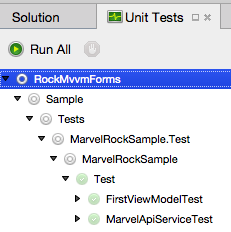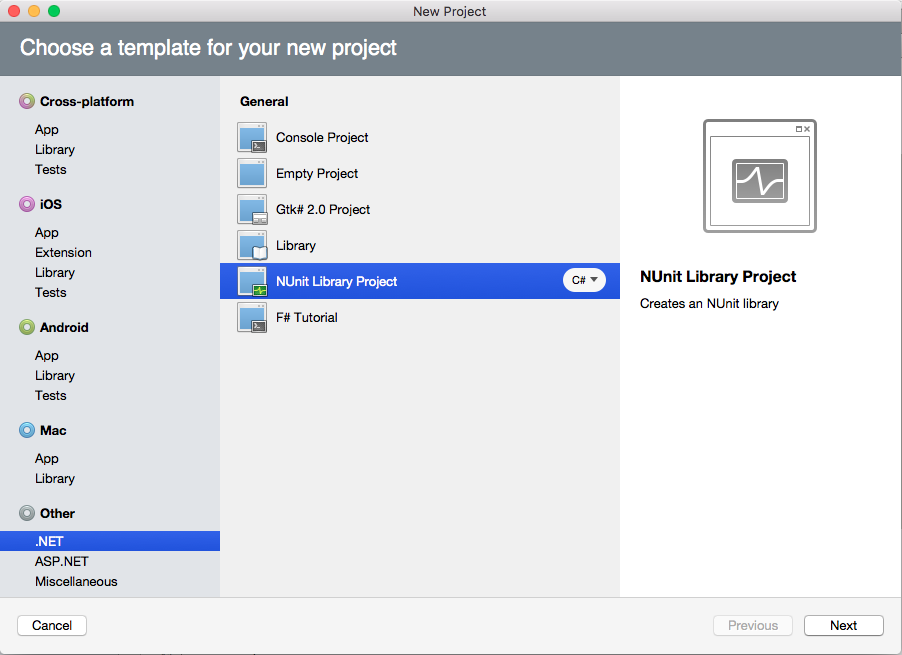
Testing Xamarin.Forms apps with RockMvvmForms and NUnit
28 Mar 2016
This is my second post about RockMvvmForms, a new and simple framework I did for my Xamarin.Forms projects.
The next logic move in the evolution of the framework is Testing. How do I test my Xamarin.Forms projects using RockMvvmForms?

If you have read my previous post, one of the principles was to use DependencyService as a Service Locator in order to leave the framework as simple as possible. Well, after trying to create a NUnit Library Project to test one of my projects, I just realized that DependencyService requires Forms to be initialized in order to use it, which means that we need to call the method Forms.Init() from a Xamarin.Android or a Xamarin.iOS project.
Xamarin provides you with Test project templates for Xamarin.iOS or Xamarin.Android, but it results in having to execute an app to run your unit tests. This could be a solution, but I prefer a NUnit Library Project to be able to execute the tests from the Unit Test runner in Xamarin Studio:

So the best option is avoid the use of the DependencyService to allocate my services and the ViewFactory. Instead we could use an IoC like Autofac, Unity, etc. or my own Service Locator.
Add RockServiceLocator
I decided to add a new Service Locator just to leave the framewrok opened to add any other types of IoC containers, if someone preffers that option.
I needed to do a couple of changes to the RockMvvmForms framework in order to simplify even more the initial setup:
Not allocate the ViewFactory in DependencyService or any other container option. So I changed the ViewFactory to a static class.
Not to use DependencyService to register my own services. Instead I will use the new RockServiceLocator.
This is the implementation of the RockServiceLocator:
namespace RockMvvmForms
{
public class RockServiceLocator
{
private static RockServiceLocator instance;
private RockServiceLocator ()
{
services = new Dictionary<Type, object> ();
}
public static RockServiceLocator Current
{
get { return instance ?? (instance = new RockServiceLocator()); }
}
/// <summary>
/// List of services
/// </summary>
private readonly Dictionary<Type, object> services;
/// <summary>
/// Gets the first available service
/// </summary>
/// <typeparam name="T">Type of service to get</typeparam>
/// <returns>First available service if there are any, otherwise null</returns>
public T Get<T>() where T : class
{
object service = null;
if (services.TryGetValue (typeof(T), out service))
return service as T;
return default(T);
}
/// <summary>
/// Registers a service provider
/// </summary>
/// <typeparam name="T">Type of the service</typeparam>
/// <param name="service">Service provider</param>
public RockServiceLocator Register<T>(T service) where T : class
{
var type = typeof(T);
if (this.services.ContainsKey(type))
{
this.services.Remove (type);
}
this.services.Add (type, service);
return this;
}
public RockServiceLocator Register<T, TImpl>()
where T : class
where TImpl : class, T
{
var service = Activator.CreateInstance (typeof(TImpl)) as T;
return Register<T>(service);
}
}
}
And this is how the initialization has changed in RockMvvmForms:
public partial class App : Application
{
public App ()
{
InitializeComponent ();
// Register the services in the Forms Service Locator
RegisterServices ();
// Register the ViewModels and asociate them to the corresponding Views
RegisterViews ();
// The root page of your application
MainPage = new RockNavigationPageService<FirstViewModel>().Create();
}
private void RegisterServices()
{
RockServiceLocator.Current.Register<IMarvelApiService, MarvelApiService> ();
}
private void RegisterViews()
{
ViewFactory.Register<FirstViewModel, FirstView> ();
ViewFactory.Register<DetailViewModel, DetailView> ();
}
}
Now that we have these changes to the framework, we will be able to create our Unit Tests.
Add Test project
We will create then a NUnit Library Project:

Testing a Service
To test a Service we have to create our own mock with fake data or use the populr Moq library available in Nuget. And this is the resulting Test class:
namespace MarvelRockSample.Test
{
[TestFixture ()]
public class MarvelApiServiceTest
{
IMarvelApiService mock;
[SetUp()]
public void Init()
{
mock = new MockMarvelApiService ();
}
[Test()]
public async void Check_Marvel_APi_when_returns_data ()
{
var results = await mock.GetCharacters (string.Empty, 0, 0);
Assert.IsNotNull (results);
Assert.IsNotNull (results.Results);
Assert.IsTrue (results.Results.Any());
}
[Test()]
public async void Check_Marvel_APi_when_filter_the_data ()
{
var results = await mock.GetCharacters ("thor", 0, 0);
Assert.IsNotNull (results);
Assert.IsNotNull (results.Results);
Assert.IsTrue (results.Results.Any());
}
[Test()]
public async void Check_Marvel_APi_when_no_data_is_returned ()
{
var results = await mock.GetCharacters ("spiderman", 0, 0);
Assert.IsFalse (results.Results.Any());
}
}
}
Testing the ViewModel
I will put here just the testing of the InitAsync call of one of my ViewModels. This is the Test class using the Mock service already created
namespace MarvelRockSample.Test
{
[TestFixture ()]
public class FirstViewModelTest
{
FirstViewModel vm;
[SetUp()]
public void Init()
{
RegisterServices ();
vm = new FirstViewModel ();
}
[Test()]
public async void FirstViewModel_init_async_test ()
{
await vm.InitAsync ();
Assert.IsTrue (string.IsNullOrEmpty(vm.SearchText));
Assert.IsNotNull (vm.CharacterList);
Assert.IsTrue (vm.CharacterList.Any ());
}
// Register services in the DependencyService Service Locator
private void RegisterServices()
{
RockServiceLocator.Current.Register<IMarvelApiService, MockMarvelApiService>();
}
}
}
As you can see our day by day as developers is to identify possible issues and refactor our code in order to continue improving. RockMvvmForms is my own tool that I use to learn and improve and I hope you find these series of Posts useful.
I have updated my previous post of how to use RockMvvmForms taking into account the refactoring I’ve done to make the framework testeable.
You can find the whole implementation in my Github account.
Thanks for visiting and enjoy!
